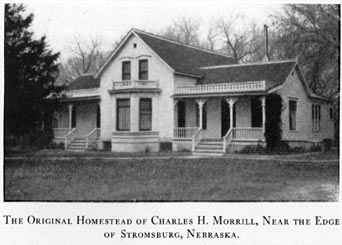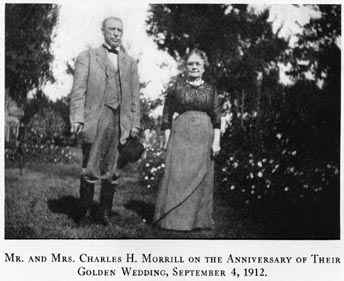[118]
THE MORRILLS AND REMINISCENCES


|
© 2002 for the NEGenWeb Project by Pam Rietsch, Ted & Carole Miller.
|
||||
NEGenWeb Project
Resource Center
On-Line Library
march with the squad of soldiers to join certain Mexican regiments.
One morning I saw ten Mexicans standing in front of the hotel with huge crates on their backs. These crates made a load about the size of a large trunk. They were filled with tomatoes. A large strap running across the forehead of the carriers steadied the load. Each Mexican had in his right hand a six-foot staff which he used as a cane. These men were on their way to Mexico City, about one hundred miles distant, over a mountain eight or ten thousand feet high. I was told that the tomatoes would bring about five dollars per crate in Mexico City. There seemed to be a tradition among the Mexicans that a yearly trip to Mexico City, where they could visit the different missions and shrines, would be of great value in saving their souls.
A TRIP TO EUROPE
Accompanied by Erwin H. Barbour, I made my first trip to Europe during the summer of 1907. Before leaving the United States, we visited many points of interest including some in Canada, namely, Niagara Falls, Buffalo, the Thousand Islands in the St. Lawrence River, Toronto, Montreal, and Quebec.
We found much to interest travelers in Quebec. To a very large degree, this is a French city. The narrow streets and buildings of ancient architecture remind one of the old cities of France. Ninetenths of the people speak French only; nearly all are Catholics.
[115]
The city is in the shape of a triangle, bounded by the St. Lawrence River, the St. Charles River, and the Plains of Abraham. The old part of the city is still surrounded by a massive wall, built for protection during the early period. In the country adjacent to Quebec, the land is divided into farms, each containing approximately one hundred and sixty acres. These farms have a frontage of about three hundred feet on the main thoroughfare or wagon road; some of them running back one or more miles. The houses, being built on the road, enable people to live near each other; this custom is said to have come down from old feudal times in France, when people were forced to live near each other for better protection. They still ride in old-fashioned two wheel shays.
The Hotel Fontenac is one of the finest hostelries on the American continent. We found many interesting historic places near Quebec, among them the Falls of Montmorency. Along the road there were many cottages occupied by French farmers. They still used open air ovens for baking bread. Behind their houses there were very long strips of farm land running down to the St. Charles River. There was also the very interesting little town of la Bonne Ste. Anne. As many as two hundred thousand pilgrims visit annually the church of Ste. Anne; its towers are over one hundred feet in height; it contains some of the bones of the patron saint, Ste. Anne. Many of those who make pilgrimages to the church believe that to touch one of these bones will bring health to the
[116]
sick; thousands of crutches have been left by those cured of their ills.
From Quebec we sailed on the Empress of Ireland and six days later arrived at Liverpool. From there we went to London, where we stopped at the Victoria hotel, near Trafalgar Square. While in London we visited the museums, and saw valuable and historical treasures from nearly every country. Nothing seems to have been so large or so weighty that the English were prevented from appropriating it, providing that it was attractive enough in art, beauty, or historic value. Just why they left the Pyramids in Egypt is not explainable.
The condition of the laboring classes in London made one wonder why so large a majority of English people were working as servants, receiving for their labor a wage which gave them bare sustenance. In conversation with waiters and stewards on boats, I was informed that many of them paid a certain amount each month for the privilege of occupying their positions; they also said that they depended entirely upon tips offered by the traveling public for remuneration for their work.
All travelers understand that there is much of great interest to be seen in London. At Windsor, for a small fee, we were admitted to the King's Palace, and also shown through his stables. Among his carriages is the old Royal Coach in which many Kings and Queens have ridden. After two weeks' stay we left London for Dover, crossing the English Channel to Calais, France,
[117]
and then on to Paris, where we remained about three weeks.
Paris is filled with interesting, historic places such as the Arc de Triomphe, Napoleon's Tomb, and the famous Louvre Galleries. At Versailles we saw many things illustrating extravagance during the reign of Louis XVI and his predecessors and their reckless expenditure of the people's money. The room of Marie Antoinette brought back visions of the French revolution. We visited the Bastile, that hideous dungeon, where so many died as a result of confinement and starvation. Our attention was called to the former location of the guillotine, where thousands were beheaded during that memorable upheaval.
Every visitor is impressed with the apparent happiness and gaiety of the French people. In dress their women are inimitable. These people sit at little tables on the sidewalks from 4 P. M. often until midnight, eating, drinking, and conversing. Even in public they show great affection for each other. On steamboats, trains and in other public places, men and women apparently belonging to the most respectable classes are demonstrative, caressing and kissing one another. I was told that this was the custom amongst French people.
From Paris we went to Lausanne, Switzerland. This city, of sixty thousand people, is located on the shore of the beautiful Lac Leman. Most of the people speak French. It is a city of hotels and pensions or boarding houses. The Swiss people are so friendly, thrifty and